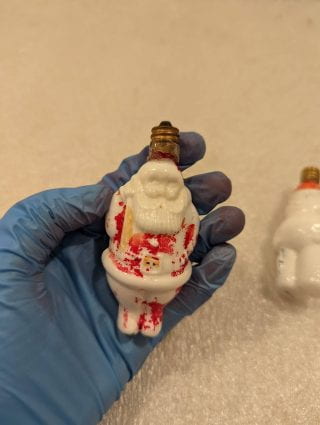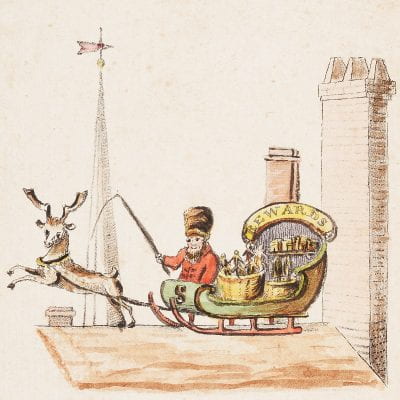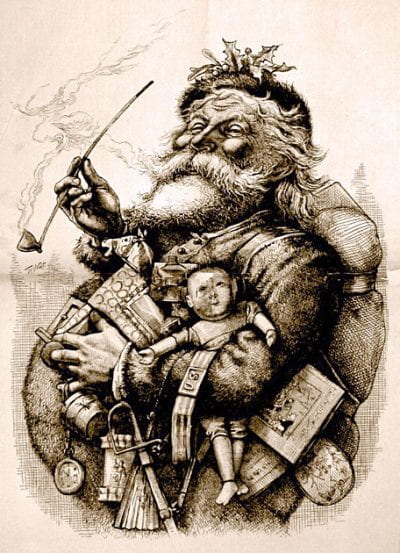Holiday Countdown
Day 22: Clothing – The Santa Suit
Author: Amy Warren is a UARK alumni who majored in Anthropology and Museum Advisory Council member.

Related Museum object: A Santa Claus lightbulb.
Santa Claus, Saint Nicholas, Kris Kringle. Few holiday images are more recognizable than Santa Claus, but the iconic appearance of this holiday hero have varied historically. Today, we explore the changing fashions of Father Christmas.
1809
The first written American account of a Santa-like figure appears in Washington Irving’s History of New York in 1809. He writes: “At this early period . . . hanging up a stocking in the chimney on St. Nicholas eve . . . is always found in the morning miraculously filled; for the good St. Nicholas has ever been a great giver of gifts, particularly to children.” Saint Nicholas is a Christian bishop known as a protector of children who gave gifts to the needy. He is depicted above in the 13th century illustration. Although the real Saint Nicholas is believed to have died in AD 343, he remains a popular saint and is celebrated on December 6th in parts of Europe.

1823
On December 23, 1823, a New York newspaper published a poem entitled “Account of a Visit from St. Nicholas.” This poem, better known as ‘Twas the Night Before Christmas, is attributed to Clement Clark Moore and is essentially the story of the transformation of the St. Nicholas pictured above (from an 1821 illustration) into something closer to what we recognize as the modern Santa Claus. The poem describes Santa as being chubby and plump and describes him as “dress’d all in fur, from his head to his foot.”

1863
In January 1863, Harper’s Weekly published a political cartoon by Thomas Nast called Santa Claus in Camp. This marks the first time that the name ‘Santa Claus’ is used, and the cartoon portrays him wearing a fur-trimmed coat, pants, and iconic stocking cap. However, his suit is not the solid red and white that we come to associate with modern Santa Claus but is instead drawn with stars and stripes—a patriotic depiction appropriate for a political cartoon appearing in the midst of the American Civil War. Later drawings of Nast served to further refine Santa’s appearance and reinforce his gift-giving nature.

1881
Thomas Nast further refines his conception of Santa Claus in the image above.
1931
Throughout the late 19th and early 20th century, the Nast portrayal became the dominant version of Santa Claus in American culture. In 1931, Coca-Cola commissioned Haddon Sundblom to develop an advertising campaign that depicted Santa as realistic and symbolic. Sundblom, drawing inspiration from Moore’s ‘Twas the Night Before Christmas drew Santa for Coca-Cola ads well into the 1960s, solidifying his interpretation of Santa Claus as the dominant one in the United States. Even if you hadn’t heard of Sundblom before, you’ve likely seen the image before! Check it out and learn more here.
Image Credits:
- Half-length portrait showing Saint Nicholas of Myra. First half of the 13th century. Unknown author. Wikimedia Commons.
- Illustration to verse 1 of the children’s poem Old Santeclaus with Much Delight. Unknown author. Wikimedia Commons.
- January 3, 1863 cover of Harper’s Weekly, one of the first depictions of Santa Claus. Thomas Nast. Wikimedia Commons.
- Thomas Nast’s most famous drawing, “Merry Old Santa Claus”, from the January 1, 1881 edition of Harper’s Weekly. Thomas Nast. Wikimedia Commons.
References:
- Baum, L. Frank. The Life and Adventures of Santa Claus. Indianapolis, Bowen-Merrill Co., 1902.
- Coca-Cola. https://www.coca-colacompany.com/company/history/five-things-you-never-knew-about-santa-claus-and-coca-cola
- History of Santa Claus in America. http://www.santasuitexpress.com/santa-claus-history.html. Accessed 10/18/2021.
- Irving, Washington. History of New York. Philadlephia, Inskeep and Bradford, 1809.
- Moore, Clement Clarke. Account of A Visit from St. Nicholas. ‘The Sentinel’, Troy, New York, 1823.
- Nast, Thomas. Santa Claus in Camp. ‘Harpers Weekly’, New York, Harpers Magazine Co., 1863.
- Saint Nicholas. https://www.biography.com/religious-figure/saint-nicholas. Accessed 10/18/2021.
- Santa Suit. https://en.wikipedia.org/wiki/Santa_suit. Accessed 10/18/2021.
- Witte, Rachel. (2019) The Man, the Myth, the Legend: Thomas Nast’s Santa Claus. Daily Art Magazine. https://www.dailyartmagazine.com/the-man-the-myth-the-legend-thomas-nasts-santa-claus/. Accessed 10/18/2021.